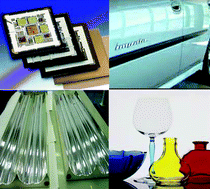Organic–inorganic hybrid materials do not represent only a creative alternative to design new materials and compounds for academic research, but their improved or unusual features allow the development of innovative industrial applications. Nowadays, most of the hybrid materials that have already entered the market are synthesised and processed by using conventional soft chemistry based routes developed in the eighties. These processes are based on: a) the copolymerisation of functional organosilanes, macromonomers, and metal alkoxides, b) the encapsulation of organic components within sol–gel derived silica or metallic oxides, c) the organic functionalisation of nanofillers, nanoclays or other compounds with lamellar structures, etc. The chemical strategies (self-assembly, nanobuilding block approaches, hybrid MOF (Metal Organic Frameworks), integrative synthesis, coupled processes, bio-inspired strategies, etc.) offered nowadays by academic research allow, through an intelligent tuned coding, the development of a new vectorial chemistry, able to direct the assembling of a large variety of structurally well defined nano-objects into complex hybrid architectures hierarchically organised in terms of structure and functions. Looking to the future, there is no doubt that these new generations of hybrid materials, born from the very fruitful activities in this research field, will open a land of promising applications in many areas: optics, electronics, ionics, mechanics, energy, environment, biology, medicine for example as membranes and separation devices, functional smart coatings, fuel and solar cells, catalysts, sensors, etc.


 Please wait while we load your content...
Please wait while we load your content...